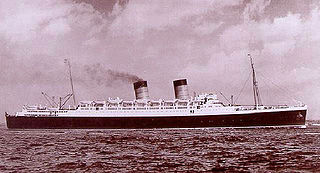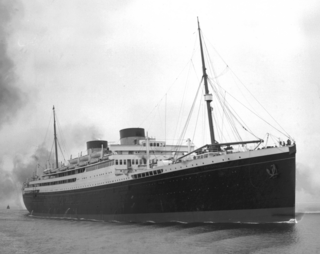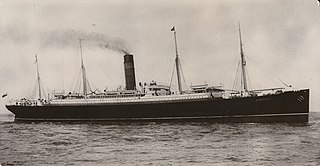
An ocean liner is a type of passenger ship primarily used for transportation across seas or oceans. Ocean liners may also carry cargo or mail, and may sometimes be used for other purposes. Only one ocean liner remains in service today.

RMS Lusitania was an ocean liner launched by the Cunard Line in 1906. She was the world's largest passenger ship until the completion of the Mauretania three months later and was awarded the Blue Riband appellation for the fastest Atlantic crossing in 1908. The Lusitania was sunk on her 202nd trans-Atlantic crossing, on 7 May 1915 by a German U-boat 11 miles (18 km) off the Old Head of Kinsale, Ireland, killing 1,197 passengers, crew and stowaways. The sinking occurred about two years before the United States declaration of war on Germany but significantly increased public support in the US for entering the war.

The White Star Line was a British shipping line. Founded out of the remains of a defunct packet company, it gradually rose up to become one of the most prominent shipping companies in the world, providing passenger and cargo services between the British Empire and the United States. While many other shipping lines focused primarily on speed, White Star branded their services by focusing more on providing comfortable passages for both upper class travellers and immigrants.

RMS Oceanic was a transatlantic ocean liner built for the White Star Line. She sailed on her maiden voyage on 6 September 1899 and was the largest ship in the world until 1901. At the outbreak of World War I she was converted to an armed merchant cruiser. On 8 August 1914 she was commissioned into Royal Navy service.

SS Oceanic was the White Star Line's first liner and first member of the Oceanic-class; she was an important turning point in passenger liner design. Entering service in 1871 for Atlantic crossings, she was later chartered to Occidental and Oriental Steamship Company (O&O) in 1875. The ship provided passenger service for O&O in the Pacific until 1895 when she was sold for scrap.

SS Imperator was a German ocean liner built for the Hamburg America Line, launched in 1912. At the time of her completion in June 1913, she was the largest passenger ship in the world, surpassing the new White Star liner Olympic.

RMS Mauretania was an ocean liner that was launched on 28 July 1938 at the Cammell Laird yard in Birkenhead, England, and was completed in May 1939. She was one of the first ships built for the newly formed Cunard-White Star company following the merger in April 1934 of the Cunard and White Star Line. On the withdrawal of the first Mauretania in 1935, to prevent a rival company using the name and to keep it available for the new liner, arrangements were made for the Red Funnel paddle steamer Queen to be renamed Mauretania in the interim.

RMS Majestic was a British Ocean liner working on the White Star Line’s North Atlantic run, originally launched in 1914 as the Hamburg America Liner SS Bismarck. At 56,551 gross register tons, she was the largest ship ever operated by the White Star Line under its own flag and the largest ship in the world until completion of SS Normandie in 1935.

SS Britannic was an ocean liner of the White Star Line. She was the first of three ships of the White Star Line to sail with the Britannic name.

RMS Celtic was an ocean liner owned by the White Star Line. The first ship larger than SS Great Eastern by gross register tonnage, Celtic was the first of a quartet of ships over 20,000 tons, the dubbed The Big Four. She was the last ship ordered by Thomas Henry Ismay before his death in 1899. The second liner of her name she was put into service in 1901. Her large size and her low but economical speed inaugurated a new company policy aiming to favour size, luxury and comfort, to the detriment of speed.

RMS Carmania was a Cunard Line transatlantic steam turbine ocean liner. She was launched in 1905 and scrapped in 1932. In World War I she was first an armed merchant cruiser (AMC) and then a troop ship.

MV Britannic was a British transatlantic ocean liner that was launched in 1929 and scrapped in 1961. She was the penultimate ship built for White Star Line before its 1934 merger with Cunard Line. When built, Britannic was the largest motor ship in the UK Merchant Navy. Her running mate ship was the MV Georgic.

RMS Teutonic was an ocean liner built for the White Star Line in Belfast and was the first armed merchant cruiser.

MV Georgic was the last ship built for the White Star Line before its merger with the Cunard Line. Built at Harland and Wolff shipyard in Belfast, she was the running mate of MV Britannic. Like Britannic, Georgic was a motorship, and not a steamer, fitted with a diesel powerplant. At the time of her launch in 1931, she was the largest British motorship.

The Olympic-class ocean liners were a trio of British ocean liners built by the Harland & Wolff shipyard for the White Star Line during the early 20th century. They were Olympic (1911), Titanic (1912) and Britannic (1914). All three were designed to be the largest and most luxurious passenger ships at that time, designed to give White Star an advantage in the transatlantic passenger trade.

RMS Carpathia was a Cunard Line transatlantic passenger steamship built by Swan Hunter & Wigham Richardson in their shipyard in Wallsend, England.

RMS Sylvania was an ocean liner built in 1957 by John Brown & Co (Clydebank), in Glasgow, for the United Kingdom-based shipping company Cunard Line. She was the last Cunard Line vessel built specifically for transatlantic crossings. The ship was later heavily rebuilt as a cruise ship, and sailed under the names SS Fairwind, SS Sitmar Fairwind, SS Dawn Princess and SS Albatros before being scrapped in 2004. She was renamed SS Genoa for her last voyage.

SS Arabic was a British-registered ocean liner that entered service in 1903 for the White Star Line. She was sunk on 19 August 1915, during the First World War, by German submarine SM U-24, 50 mi (80 km) south of Kinsale, causing a major diplomatic incident.

The first RMS Saxonia was a passenger ship of the British Cunard Line. Between 1900 and 1925, Saxonia operated on North Atlantic and Mediterranean passenger routes, and she saw military service during World War I (1914–1918).

The Jubilee class were a group of five passenger and cargo ocean liners built by Harland and Wolff at Belfast, for the White Star Line, specifically for the White Star Line's service from the UK to Australia on the Liverpool–Cape Town–Sydney route. The five ships in order of the dates they entered service were:




















